|
Old Wattling Street / Crutches Lane
Frindsbury/Gadshill
01634 290148
https://whatpub.com/three-crutches

Above photo, circa 1930. |
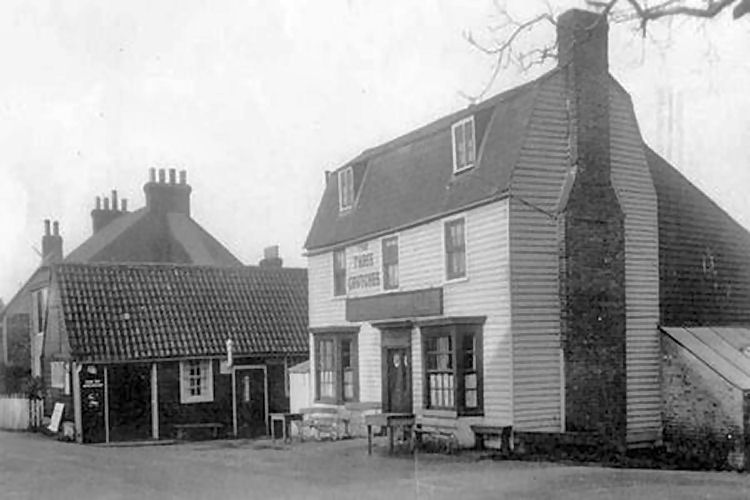
Above photo, circa 1930. |
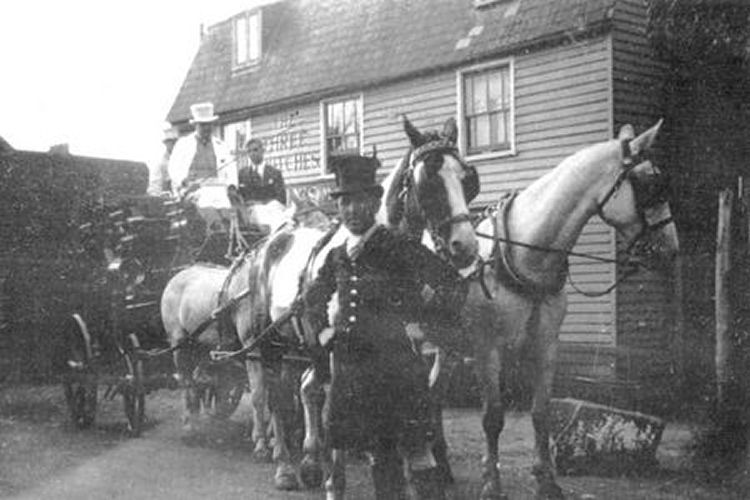
Above photo showing a carriage outside the pub circa 1920-30s. |
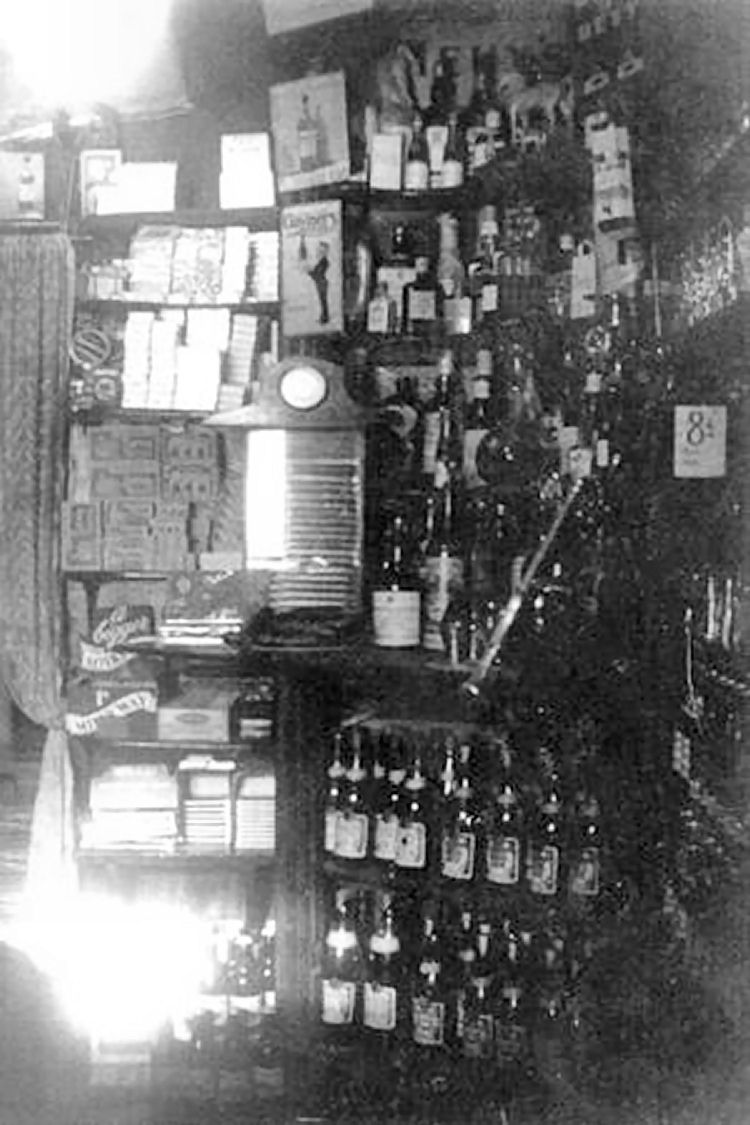
Above photo showing the inside of the pub. Date unknown but Milky Way
cost 1d. |
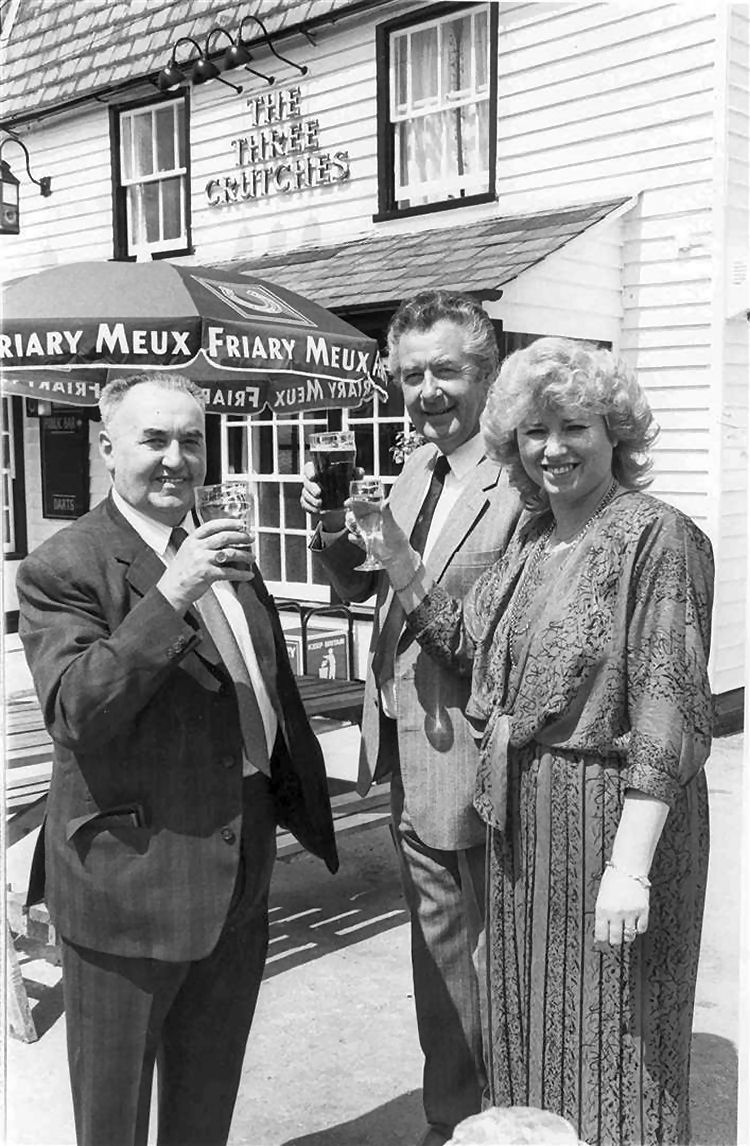
Above photo, July 1988, showing Eric and Pat on the right, managers
with a brewery representative, left. |
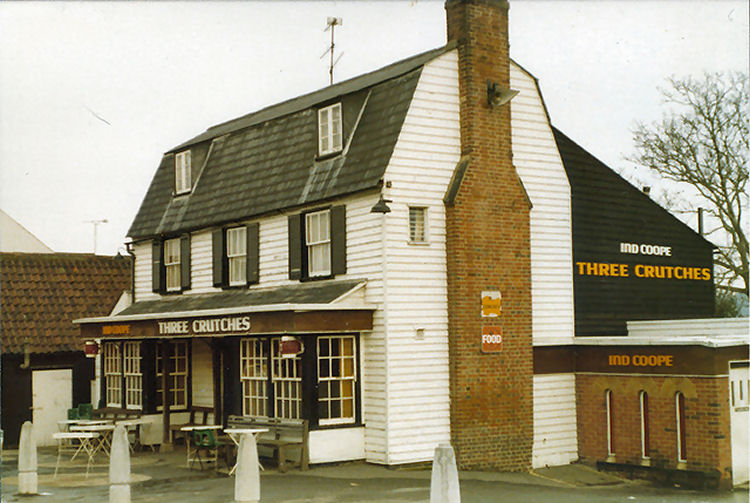
Above photo 1978. |
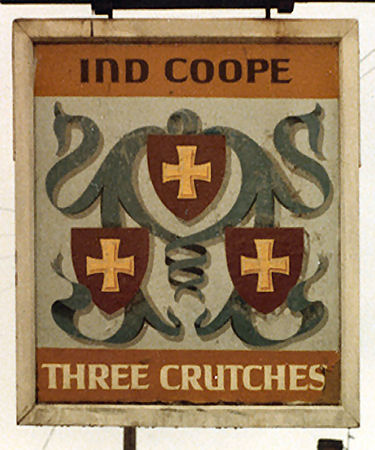
Above sign 1978. |
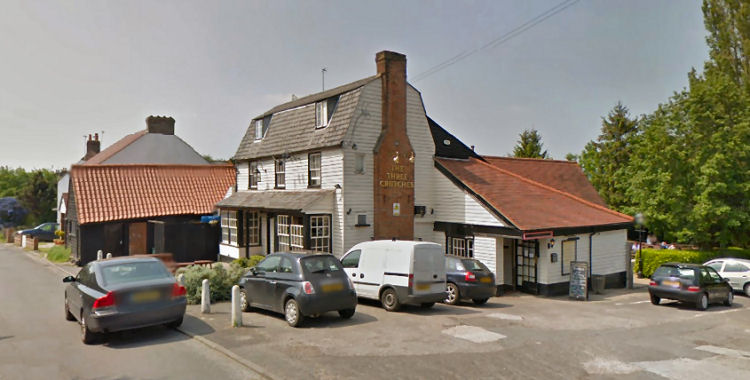
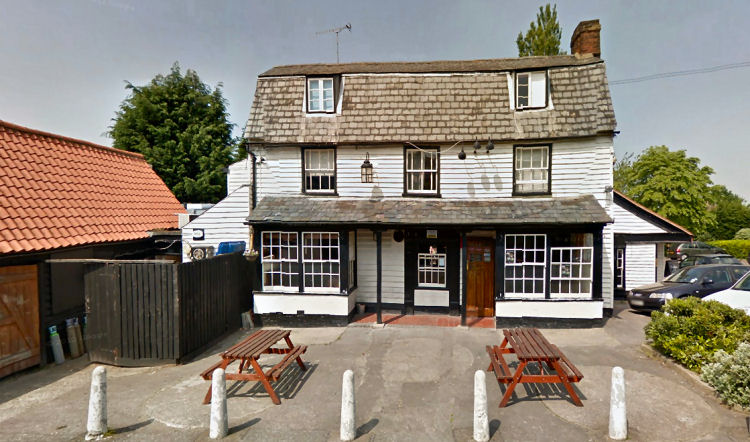
Above images from Google Maps 2012. |
I also have reference to a "Bear
and Ragged Staff" and originally believed that this pub was called
this before changing name some time before 1847. However, Richard Shaw
informs me that the census for 1841, shows his 3 times great grandfather
Thomas Sansom, a farmer, who was living at Crutches Farm, and is recorded as
renting land on the farm. His son, 2 times great grandfather Henry Sansom,
is recorded as living next door on Cobham Lane, and his occupation was
recorded as a Publican. Unfortunately the name of the pub was not identified
on the census.
The front of the building is Grade II listed and there is a traditional
feel about the place with two fireplaces in the top bar and a third in the
lower bar/family dining area.
|
Kent Herald, 7 August 1845
On Thursday last an inquest was held before J. Hinde, Esq., coroner, at the
"Crutches," Frindsbury, on the body of George Blackman, a young man age 21
years, in the employee of Mr. W. Miles, of Read Court.
It appeared that on the 22nd July the deceased was riding a mare belonging to
his master; on coming to a gate she reared and fell upon the deceased, when he
received a compound fracture of the left leg. Mr. Edwards, surgeon, deposed that
he attended the deceased and reduced the fracture, and that all went on well up
to Monday evening following, when the deceased was taken with lockjaw, which
increased during the night so much that he deemed it necessary to amputate the
leg, as the only chance of saving the life of the deceased, which operation he
performed with the assistance of Mr. Robertson, but he died very soon
afterwards.
Verdict:- "That the deceased died from lock jaw, occasion by an accidental
fracture of the leg."
|
|
Kentish Gazette, 9 February 1847.
Fatal Death by Fighting.
On Thursday afternoon, the 4th inst., an inquest was held by J. Hinde,
Esq., one of the county coroners for Kent, on the body of a labouring man, named John Dalton,
of the parish of Shorne next Gravesend.
The body, which exhibited several marks of violence,
laid at the "Crutches" public-house, where the fatal occurrence took
place, leading on the road towards Cobham, and at which
house the jury assembled. It appeared from the evidence of William
Sledman and John Day, two men who were with others in the
tap-room of the public-house on the evening of Saturday, the 30th ult.,
that the deceased and a man named William Fielder were
aggravating each other, they both being intoxicated. The deceased
offered to fight William Fielder, if Fielder would take off his coat.
Fielder did so, and then the deceased ran out of the front door, and
Fielder followed him. They returned into the tap-room, to all
appearance friendly, and the deceased called for some beer, but the wife
of the landlord refused to draw it. Fielder and the
deceased began to quarrel again. The result was that the parties fought
together outside the door, and in the course of the fray the
deceased fell, and when picked up he was found to be dead. The coroner
remarked, that under the circumstances which had come
to his knowledge, he should adjourn the inquest, and instruct a medical
man to make a post mortem examination of the body. The
court was then adjourned.
|
|
Dover Chronicles 13 February 1847.
Death from fighting.
On Monday last an adjourned inquest was held by J. Hinde, Esq,
coroner, at the "Crutches" public house, Frindsbury touching the
death of John Dalton, a wood cutter, of Shorne, who had died on
Tuesday, through injuries received in a fight with William Fielder,
also a wood cutter from the same village, which took place on the
previous Saturday evening.
Since the death of Dalton, Fielder had been confined to the lock-up
house at Chatham, and was brought up in custody.
It appeared that on the evening of the fight deceased with the
prisoner and several other labouring men, we're in the taproom of
the "Crutches" public house drinking together; both of them were
intoxicated. The deceased took Fielder's cap from off his head, and
having first extinguish the candle with it, threw it on the fire.
Words insude; Dalton challenged the prisoner to the combat; and they
left the house, accompanied by their companions, to whom great blame
attaches for not having prevented the fatal affray. Seconds being
appointed, several rounds were fought, in which the deceased
repeatedly fell, striking the back part of his head against the
ground with great force violence; and not withstanding the repeated
wish of the prisoner not to fight, the wrestling continued, tell at
length Dalton was raised from the ground speechless and insensible.
His companion thinking it more the effects of the drink than the
fight, left him lying on the four-corner ground for nearly an hour,
when he was taken into the house and put the bed.
The next morning Mr. Steele, surgeon, of Strood, was called to
attend the deceased, and on his arrival he found him in a state of
insensibility, the pupil of the left eye very much dilated, and the
pulse full and strong. He found a lacerated wound over the right
eyebrow, (which had appeared have been caused by the deceased coming
in contact with the latch of the door during the scuffle,) and a
small wound on the forehead. He adopted the usual treatment for
compression of the brain; but deceased, who remain insensible,
became gradually worse, and died early on Tuesday morning. By the
coroner's order, he had since made a post-mortem examination. On
examining the head he found some trifling effusion of blood under
the scalp, at various places on the back and sides of the head. On
opening the dura mater he found an extensive effusion of blood under
the whole of the left parietal bone and smaller effusions of serum.
The other portions of the brain were healthy, and there was no
fracture or depression of the skull. He was of opinion that death
rose from violence received on the head, which produced effusion of
blood and compression of the brain.
By the coroner:- As far as you can form an opinion, what was the
violence on the head?
Witness:- The violence might have been caused by repeated blows or
by frequent falls; he was inclined to think that death arose from
the latter circumstance.
The prison being asked by the Coroner if he wished to say anything,
replied that he was very sorry for what had occurred - no man could
be more so.
The Coroner then summed up; and having briefly explained the law in
reference to murder and manslaughter, told the jury the question for
them to determine was, whether the prisoner have been guilty of the
crime of manslaughter.
The room was then cleared, and the jury remained for nearly 2 hours
in deliberation, and ultimately returned a verdict of "Accidental
Death."
|
|
From the Maidstone Telegraph, Rochester and Chatham Gazette, 10 August 1861.
Rochester and Chatham. Shocking Death.
On Monday an inquest was held at the "Brickmakers Arms," Cuxton Road,
before B. Marsh, Esq., deputy coroner, on the body of John Atherfold,
age 65, who met his death on the London, Chatham, and Dover Railway,
under the following shocking circumstances. The deceased, a farm
labourer, was returning to his lodgings at the "Three Crutches" public
house, near Strood, and in doing so had occasion to cross the railway
where there is a footpath over a level crossing. On attempting to do so,
however, the 4.15 p.m. train from the Victoria station came up at a
great speed, and although the driver attempted to attract the attention
of the deceased by sounding the whistle, he appeared to take no notice
of it, and before he got clear of the metals the engine caught him and
mangled his body in a frightful manner. The deceased was very deaf.
The jury returned a verdict of "Accidental Death," and recommended that
the public crossing at the spot in question should be abolished, and a
tunnel made for foot passengers.
|
|
From the Cambridge Independent Press, Saturday 310 July 1886. Thomas
Staples, landlord of the "Three Crutches Inn," Cobham Road, near
Rochester, was found hanging by his neck in his stable the other day.
|
|
From the Dundee Evening Telegraph, Saturday 19 November 1938.
Dick Turpin said with hidden gold at Inn.
Workmen who carry out alterations to be made at the "Three Crutches," a
300 year old, wood built-in on Watling Street, near Rochester, Kent,
will have a treasure hunt thrown in.
According to tradition, Dick Turpin once hid a bag of gold pieces in one
of the walls of the inn, and never came back to claim it.
The tale has been handed down from generation to generation of the
country folk in the district and is still giving much credence.
Kent historians quote the exploits of one, "Nick of the Bay Mare," who
is said to have held up a coach at Gad's Hill at four o'clock one
morning, to have escaped across the Thames at Gravesend, and to have
arrived in York the same afternoon. This is claimed to have been the
origin of the legend of Dick Turpin's ride to York.
Smallest bar.
Close to the inn as a deep cave where highwaymen could have found shelter,
and in what is now the garden of the inn was a spring which was the only
fresh water supply for miles around.
It was first proposed to pull the inn down and erect a new one, but to
preserve its atmosphere and it's associations, it was decided only to
make alterations. These will involve the enlargement of what is said to
be the smallest bar in England. It measures only 9 feet by 6 feet, and
it's counter is only 4 feet long.
The "Three Crutches" has associations with Charles Dickens, too. Mr.
Joshua Nicholls, the landlord, told a reporter:- "Dickens was a visitor
when he lived at Gad's Hill Place. Old people still remember him sitting
in the tap room with a glass of ale and a pipe playing crib.
Killed by arrow.
Near this spot Sir Reginald Braybrooke, a Knight Templar, was killed by
an arrow shot from a tree. On the site of the crime his brethren erected
a memorial of three crosses to him.
Years later another Templar riding the same way sought shelter from a
storm in a cottage and found there a dying woman covered with Sir
Reginald's cloak. She confessed that her husband, fancying himself
wronged by Sir Reginald, had shot the fatal arrow, and then, mad with
remorse, killed himself.
"Three Crosses" became corrupted to "Three Crouches," then to "Three
Crutches."
|
|
Kent & Sussex Courier 26 May 1939.
A George 3rd penny (1760-1820) has been found during alterations to the 300 year old
"Three Crutches Inn," near Cobham, Kent. |
|
Information below taken from
http://www.mysteriousbritain.co.uk 2014.
HISTORY OF THE THREE CRUTCHES
One night in the 13th century a Templar Knight named Sir Richard or
Reginald Braybrooke was murdered whilst travelling (probably) to Temple
Manor after visiting Lord Cobham. He was shot through the heart by and arrow
and his body was not discovered until the following day at a location where
three roads met. The murderer was never caught or brought to justice. A
three sided monument in memory of Sir Richard Braybrooke was erected at the
scene of the killing and on each of the three sides was a cross. The site
was henceforth known as 'The Three Crosses'. The monument has long since
been lost, though the old public house called 'The Three Crutches' is
thought to be close to the site of the murder and is thought to be named
after the 'The Three Crosses'. It has been suggested that Crutches
(pronounced 'crootches') is possibly an old country name for 'crosses', and
that the Inn was originally known as 'The Three Crouches' before a more
recent landlord changed its name to 'The Three Crutches'.
Henry Smetham in his 'History of Strood' (1899) gives the following
account of the legend and throws some doubt on the connection between the
Inn and the murder site. "The village of Luddesden, at a short distance from
the river, and on the road to Cobham Park, is connected with an old legend
of the Medway and the ruins of the Temple.... When the Knights Templars
flourished in all their glory, one of their members, Sir Reginald Braybrooke,
had been to visit the Lord Cobham, and was returning to the Temple by a
lonely path on the river's brink, when he was pierced to the heart by an
arrow from a hand unseen. Next morning he was found weltering in his blood,
quite dead, and the fatal arrow still sticking in his side. The Templars
used every means to discover the assassin, but in vain; and in commemoration
of the deed, and to solicit the prayers of all faithful passengers for the
soul of their brother, they erected a triangular monument on the spot where
the corpse was found, with a cross on each side, fronting the three roads
that united at this place. The spot ever afterwards obtained the name of the
Three Crosses. The murderer was not discovered during his own lifetime; but
the secret was brought to light in a singular manner.
"On one bitterly cold winter night, some years afterwards, one of the
brethren, who had been to administer the last consolations of religion to an
expiring sinner, arrived at Luddesden in a woeful plight from cold and
exhaustion. He saw but one light, from the window of a poor hovel in the
village, and, knocking at the door, he entered to solicit shelter and a seat
by the fire. He found the place inhabited but by one poor old woman, who was
sick in bed. She was almost in the last extremities, and the instant the
ecclesiastic entered, he remarked that the coverlet of her bed was no other
than the cloak of the murdered Sir Reginald Braybrooke, whose confessor he
had been. He immediately conjured her, ere she hastened into the presence of
her God, to tell whether she knew anything of the murder. She then confessed
that her husband, an old soldier, who had fancied himself wronged and
insulted by Sir Reginald, had shot the fatal arrow to his heart; that after
the commission of the deed he never enjoyed one moment's repose or
happiness, and that one morning, a few months afterwards, he was found at
the bottom of the chalk pit dashed to pieces. She did not know whether this
catastrophe was accidental, or whether in a fit of remorse he had put an end
to his miserable life. Having made this confession she expired, and the
priest, taking away the cloak, conveyed it to the Temple, where it was long
preserved by the Knights as a sad relic of their brother.
"The precise spot where the monument stood is not now known, all traces
of it having long since disappeared. A small public house in the
neighbourhood has borrowed a name from it, with a most whimsical perversion.
From Three Crosses, the original name of the monument, it was corrupted in
the course of time to the Three Crowches; and a modern landlord, seeing no
meaning in these words, improved it, and made it more intelligible to his
customers, by giving his house the sign of the ' Three Crutches.' Close to
this house, on a rising ground over-shadowed by one of the largest walnut
trees in England, is the spring that formerly supplied the pilgrims to this
spot with water."
The explanation lies probably in the following:-
Crouch, a cross (from the Latin crux). That all cross-roads had formerly
a cross of wood or stone near the intersection, is pretty clear from the
names still retained as John's Cross, Mark Cross, Stone Cross, High Cross,
Hand Cross, New Cross, Wych Cross (perhaps so named in honour of St. Robert
de la Wych, Bishop of Chichester). All these and many others occur in
Sussex. [These crosses served also for direction posts. Probably this was
their primary use, the religious idea being an afterthought.] At Seaford
such a spot bears the name of " the Crouch." We find also High Crouch,
Katty's Crouch [St Katherine's], Fair Crouch, Crow Crouch, &c., &c. Crouched
or Crutched Friars were an order of religion, who bore a cross upon their
robes. The name crutch applied to the supports used by cripples is evidently
from the same root. A person dwelling near some wayside cross would feel
proud of such an appellative as, John atte Crouch, a form in which the name
frequently occurs. Croucher is another form of the word.
This narrative, in its application to the inn concerned, is open to
doubt. It is difficult to conjecture " the lonely path on the river's brink
.... fronting three roads that united at this place," leading from
Ivuddesdown to the Temple. Again, it is rather a far cry that a murder at a
spot so far removed from the " Three Crutches " inn on Cobham Road, should
give rise to its name. The writer has also been informed that the anterior
name of the "Three Crutches " inn was The "Bear and Ragged Staff." His
informant was an old lady, now dead, who was born there.
The Three Crutches Inn is also said to be haunted by two ghosts.
One is seen sitting at an upper floor window. The other is a finely
dressed man who walks through the wall in the dining room.
Nearby are four sarson stones which were found during roadworks. They
have been set up in a four poster like setting.
|
|
From http://www.ghostpubs.com accessed 17 June 2015.
HAUNTED.
At this six centuries old Second-grade pub with weatherboarding and
slate roof, the inn sign shows Cruched Friars, who were distinguished by
one cross on their habits ‘Cruches' is a corruption from the Crossed
Friars, who were of the Holy Cross order. They wore a red cross on their
habit and carried a silver cross before them as they travelled. At least
two ghosts haunt this pub. The proprietor mentioned that she, with a
number of employees and regulars, have seen a well-dressed ghostly man.
He walks through the public bar and into the dining room where he
disappears. “But he seems quite a harmless old ghost'' she said. Another
ghostly figure, witnesses have seen, leaning through a window of a
locked and empty room on the top floor waving, with laughing at people
passing by.
|
LICENSEE LIST
ODDS George 1851-58+ (age 42 in 1851 ) )
 
ROWE Benjamin 1861-74+ (age 44 in 1861 ) )
 
BROOMFIELD John 1881+ (age 44 in 1881 ) )
STAPLES Thomas to July/1886 dec'd
OFFEN Alfred to Jul/86-87 dec'd
OFFEN Ann 1887-92 dec'd

HAWES John William 1901-03+ (age 63 in 1901 ) )
 
JUDGES Joseph B 1913-22+
  
JUDGES Mrs Maud 1930+

NICHOLLS Joshua & Eliza 1938-39+ (age 68 & 66 in 1939)

NICHOLLS Redvers William 1955+
STAGG Jim to 1985
WELSH Paul & Kairen 1985-88
???? Eric & Pat 1988-94
GWYTHER Alan & Lesley 1994-97
???? Jane 1997-2004
Temps 2004-2009
LEWIN Andy 2009-17
COWARD 2012-22+
https://pubwiki.co.uk/ThreeCrutches.shtml
 Census Census
 From the Post Office Directory 1855 From the Post Office Directory 1855
 From Melville's Directory 1858 From Melville's Directory 1858
 From the Post Office Directory 1862 From the Post Office Directory 1862
 From the Post Office Directory 1874 From the Post Office Directory 1874
 From the Post Office Directory 1903 From the Post Office Directory 1903
 From the Kelly's Directory 1903 From the Kelly's Directory 1903
 From the Post Office Directory 1913 From the Post Office Directory 1913
 From the Post Office Directory 1918 From the Post Office Directory 1918
 From the Post Office Directory 1922 From the Post Office Directory 1922
 From the Post Office Directory 1930 From the Post Office Directory 1930
 From the Post Office Directory 1938 From the Post Office Directory 1938
|








